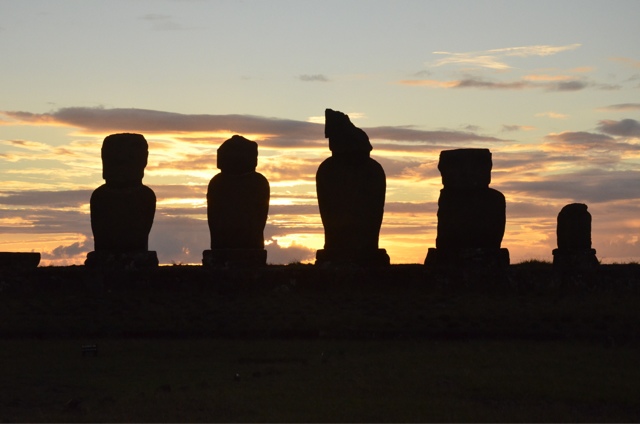The end of the holiday. We are on the flight back to London, and we are re-living our amazing adventure as we look through our photographs. What were the highlights? The lowlights? The things we would do differently?
HIGHLIGHTS:
In truth, the whole holiday was one big highlight, but if we had to pick out the absolute best bits, they would be these:
Perito Moreno Glacier.
Without a doubt, the number 1 highlight. We were blessed with great weather, and I am sure that made a huge difference . To hear and see the ice breaking away from 60metre high cliffs and falling into the water was incredible. To walk upon the glacier using crampons was simply an amazing, once in a lifetime experience.
Easter Island
Unbelievable. The size, the number, the enormity of carving so many Moai from the rock and then transporting them across the Island was simply staggering.
The Reloncavi , Puerto Montt, Chile
Pucon -Chilean Lake District
For the snow-capped volcano views and hiking in Huerquehue National Park
The Ruins of Quilmes
Little known, but a massive and important historical site, clinging to the mountainside in a great state of preservation. Reminiscent of Macchu Pichu, but in an arid, rather than a green setting. The sight of the condor, soaring close overhead, was simply unforgettable.
Cafayate to Salta via Cachi
A demanding 8 hour drive across mountain passes on poor, dirt track roads, but with unsurpassed views and incredible landscapes.
There are so many more I could mention: hiking to the base of the glacier at Ushuaia; the friendliness
of the Argentine people; the great wines of Mendoza and Cafayate; pisco-sour;horse-riding on an Estancia in Uruguay; beach combing in Jose Ignacious;
some of the wonderful accommodation that we stayed in, particularly Ushuaia, El Calafate, Fundo Los Guindos in the Chilean Lake District, Cafayate Wine Resort, and Salta; great food, the most surprising being at a roadside cafe opposite a gas station in the desert at St Agustin del Valle Fertil, the most romantic being Kuar restaurant in Ushuaia, and the most stylish being Cafayate Wine Resort. The list is endless.
of the Argentine people; the great wines of Mendoza and Cafayate; pisco-sour;horse-riding on an Estancia in Uruguay; beach combing in Jose Ignacious;
some of the wonderful accommodation that we stayed in, particularly Ushuaia, El Calafate, Fundo Los Guindos in the Chilean Lake District, Cafayate Wine Resort, and Salta; great food, the most surprising being at a roadside cafe opposite a gas station in the desert at St Agustin del Valle Fertil, the most romantic being Kuar restaurant in Ushuaia, and the most stylish being Cafayate Wine Resort. The list is endless.
LOWLIGHTS:
Very few.
Puerto Montt
Dirty, unattractive city, with chaotic road system, whose saving grace was the excellent Holiday Inn hotel.
Buenos Aires underground system.
Coffee in Chile
Nescafé only!
Hotel La Agauda in San Fernando Del Valle De Catamarca
The disaster of the closed hotel.
Dogs
The huge number of abandoned puppies and dogs throughout South America. Two gorgeous puppies followed us around the Moai quarry on Easter Island. We would so like to have brought them home. A local guide told us that a week earlier there had been two more, but these had died.
Spiders in Uruguay
Didn't bother me, but Anni insists I mention the 3 dinner-plate sized spiders that crossed the road in front of us.
THINGS WE WOULD DO DIFFERENTLY
Add more flexibility by only pre-booking the key elements before departure from the UK, then planning just a few days ahead at a time. The widespread availability of the Internet in South America would have made this easy to achieve. We could easily have stayed for twice as long (10 weeks) and done things at half the pace.
We could have travelled more by bus and less by plane. The journeys may be long (i.e 20 hours compared to a 2 hour flight) but the buses are comfortable, frequent, and reliable, and cost a fraction of the air fare. The cost saving would have financed a major extension to the duration of the holiday
Mendoza to Salta was a long, but amazing 4 day drive. The one-way car hire was extortionate. You could easily spend three or four times as long exploring this area. On another occasion I would take the bus from Santiago to Mendoza across the Upsalla Pass, hire a car in Mendoza and explore the very pleasant city and the vineyards of the area, then maybe take a further 4 days to visit the Ischigualasto and Talampaya National Parks, before returning to Mendoza and flying back to Santiago. From there I would make my way up to the salt flats of the Chilean Atacama desert, before crossing back into Argentina at Salta. At Salta, I would again hire a car for at least 4 days, take the 4 hour drive on the quick main route to Cafayate, spend at least 2 nights there enjoying the vineyards, and drive back to Salta on the mountain route stopping half-way overnight at the lovely Molinos Hacienda.
ONE LAST TIP
We didn't take the cruise to Antarctica. At from $5,000US to $10,000US it was
simply too expensive. However, in Ushuaia, we were offered the same tour for $1,000 as a cruise ship had unsold cabins. If you can build flexibility into your itinerary, and have the luck to be offered such an amazing opportunity, take it!
simply too expensive. However, in Ushuaia, we were offered the same tour for $1,000 as a cruise ship had unsold cabins. If you can build flexibility into your itinerary, and have the luck to be offered such an amazing opportunity, take it!



























































